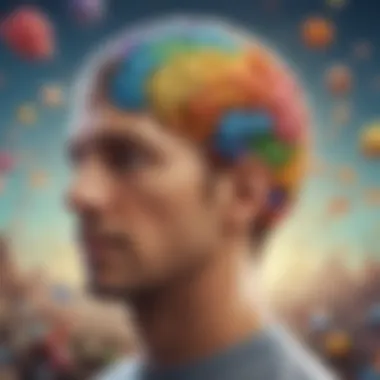Exploring Personal Transformation in Breaking the Habit


Intro
In today's fast-paced world, many of us find it challenging to break free from the usual patterns that define our lives. Breaking the Habit of Being Yourself by Dr. Joe Dispenza tackles exactly this dilemma. It emphasizes the power of transformation and offers various pathways to reconstruct one's identity. At its core, the book invites readers to confront their habitual thoughts and behaviors, paving the way for profound personal change.
Understanding that the mind and body are intrinsically linked is a pillar of the text. By becoming aware of our mental cycles, we can challenge the automatic responses that dictate our behaviors. This represents a significant turning point for those seeking advancement—beyond just self-help advice.
Key Concepts and Insights
Main Ideas from the Book
The crux of Dispenza's argument is that many individuals are prisoners of their own positive and negative habits. The habitual thinking patterns are not merely reflections of past experiences but active forces shaping our current reality. Some pivotal concepts introduced include:
- Neuroplasticity: The brain's ability to rewire itself. Dispenza presents ways in which we can engage in mental practices that reshape our thought processes.
- Meditation: Emphasized as a tool for mental transformation, meditation not only calms the mind but also facilitates a deeper understanding of one's habitual thoughts and feelings.
- Emotional State Dynamics: It is posited that emotions, whether uplifting or debilitating, play a crucial role in sculpting our identities. Understanding and controlling these states is vital for personal evolution.
Dispenza’s work backs its theories with examples from neuroscience, suggesting that change begins at the mental level. A deeper familiarity with these ideas allows readers to recognize how their thought patterns can dictate their life outcomes.
Practical Applications of Concepts
Real-world implementation of these ideas is essential for those wanting real change. Here are a few actionable approaches:
- Daily Mindfulness Practice: Cultivating awareness of thoughts can help in noticing patterns that hinder growth.
- Setting Clear Intentions: Intentions act as a compass. Knowing what you truly desire is the first step in rerouting your mental maps.
- Visualizations: Envisaging oneself in desired scenarios can bridge the gap between current and future selves.
Engaging in these practices can sound straightforward, yet they require persistence and self-compassion. Many find journaling their progress can serve as a scaffold, facilitating reflections on the changes they're making.
"To change is to think greater than your environment."
This concept serves as a reminder that true transformation involves diligence and consistent practice.
Recommendations and Further Reading
Delving deeper into the themes of Breaking the Habit of Being Yourself, several other resources can enrich this exploration:
Related Books to Explore
- The Power of Now by Eckhart Tolle
- Mindset: The New Psychology of Success by Carol S. Dweck
- Atomic Habits by James Clear
These texts extend the conversation about personal growth, offering various perspectives on how habits and mindsets influence our lives.
Additional Resources for Personal Development
- Explore articles on Wikipedia that cover neuroscience and personal development.
- Engage with communities on Reddit discussing self-help strategies.
- Check discussions about the book on Facebook.
In summary, by integrating the insights discussed in Breaking the Habit of Being Yourself with other valuable resources, readers can embark on a deliberate journey of self-discovery and transformation.
Prelims
In the realm of self-help and personal growth, the theme of breaking free from old patterns has gained significant traction. The first step in this exploration is recognizing the profound impact of habits on our lives. Why does this matter? To put it simply, our habits often define who we are. They shape our daily actions, our responses to challenges, and even our future. When one seeks to evolve, understanding and disrupting ingrained habits becomes crucial.
It’s more than just an intellectual exercise; it’s about fostering a sense of awareness. Think of habits as the invisible scripts that guide our daily interactions—They're the routines that have become second nature, the unconscious behaviors that, at times, may not serve our true intentions. When we begin to interrogate these worn patterns, we create an opening for transformation, allowing us to rewrite our narratives.
To pull the curtain back a bit, this article delves into the various dimensions of transforming oneself, exploring the delicate interplay between mental constructs and emotional realities.
A few key pointers to consider when diving into this topic include:
- The science of how habits form and what keeps them in place.
- The significant role of self-perception in molding one's identity.
- Practical strategies and emotional intelligence as tools for cultivating lasting change.
"We can’t change what we don’t see; the power lies in the recognition of our patterns."
As we unravel these topics, the focus will shift from a mere understanding of habits to exploring actionable strategies that promote change. This journey not only aids in breaking negative cycles but also paves the way for a more authentic self. Thus, this exploration is not merely an academic endeavor, but a call to every reader—whether you’re a student grappling with self-doubt or a professional seeking greater fulfillment—embracing the gift of transformation awaits.
Understanding Habits
Understanding habits is crucial, especially when discussing the nuances of personal transformation. Habits shape our daily lives, often without us even realizing it. They're intricately woven into the fabric of our existence. By grasping the mechanics behind habits, we set the stage for the kind of self-improvement many are eager to achieve.
Being aware of what constitutes a habit gives us insight into how to reshape them. What we rely on daily is not mere routine; it's an intricate dance of thoughts, feelings, and actions. Recognizing this can change the way individuals perceive their day-to-day lives. When we talk about breaking the habit of being ourselves, we engage with an understanding of how deeply entrenched these habits are. A simplistic view can lead to misconceptions, which may hinder effective personal growth.
What Constitutes a Habit?
At its core, a habit is a behavior that tends to occur automatically, triggered by specific cues in the environment. It's like a default setting that a person falls back on, often without questioning it. For example, consider the ritual of checking your phone the moment you wake up. This act, seemingly innocuous, is part of a habit loop. The cue here is the morning; the routine is checking the phone; and the reward is the immediate gratification of connecting with the digital world.
Breaking down what constitutes a habit involves recognizing a few key aspects:
- Cue: This is the trigger for a habit; it could be a feeling, a specific time of day, or an event.
- Routine: This is the behavior itself, which can be seen as the action one takes.
- Reward: This is the benefit gained from completing the behavior, which encourages repetition.
Understanding these components helps individuals analyze their habits more critically, leading to more effective change.
The Science of Habit Formation
The science behind habit formation digs into our psychology, highlighting how behaviors become habitual over time. According to research, habits form through repeated actions that create neural pathways in the brain. The more frequently an action is repeated, the stronger and more automatic the connection becomes. This is how contrasting habits can develop; for instance, someone might develop a habit of reaching for a sugary snack in response to stress rather than opting for a healthier choice. This is not just about choice but also about the brain's wiring.
The process is cyclical and often described in three phases:
- Trigger: An external or internal cue.
- Behavior: The action taken in response to the cue.
- Outcome: The result of the action, which can create a feeling of satisfaction or relief.


When aiming to break existing habits, it is essential to disrupt this cycle. Unraveling deeply ingrained habits comes down to identifying triggers and considering alternative responses.
Neuroscience Insights
Neuroscience plays a pivotal role in our understanding of habits. Research pinpointed the significance of the basal ganglia and the prefrontal cortex in habit formation and maintenance. The basal ganglia are like a bulldog, holding onto those automatic behaviors, while the prefrontal cortex allows for planning and decision-making.
When attempting to break free from habitual actions, the struggle often lies in challenging these neural pathways. It requires focused effort and intention to forge new paths in the brain, eventually leading to improved behavior patterns.
"The brain is like a muscle; it gets stronger with use. To rewire it, we must engage in consistent practice and mindful awareness."
This blend of biological understanding and psychological insight illuminates the complexities of habits and emphasizes that change is possible with persistent effort.
Mental Constructs
The notion of mental constructs occupies a crucial role in the overarching theme of personal transformation addressed in Breaking the Habit of Being Yourself. These constructs influence not only how we perceive our selves but also how we navigate through life’s myriad challenges. In essence, understanding mental constructs is about dissecting the layers of thought and perception that shape our identity and behavior. This section delves into crucial components such as self-perception, thought patterns, and the beliefs that act as the building blocks of our behavioral frameworks.
The Role of Self-Perception
Self-perception is foundational to our understanding of who we are. Essentially, it is the lens through which we view ourselves and our capabilities. Think of it like a mirror that reflects not just your physical appearance but also your thoughts, feelings, and even your past experiences. If you see yourself as a failure, chances are, your actions will align with that belief, perpetuating a cycle of negativity.
Conversely, a positive self-image can propel you to achieve more than you ever thought possible. This emphasizes the importance of nurturing a healthy self-perception, as it determines the motivation behind your actions. By reassessing how you view yourself, you can initiate significant changes in your behavior and habits.
Thought Patterns and Identity
The patterns in your thoughts are like the threads woven into the fabric of your identity. They dictate how you react to circumstances and interact with the world around you. For instance, if you habitually approach challenges with a defeatist attitude, then it’s no surprise that you find it hard to embrace change.
Changing your thought patterns isn’t just about thinking more positively—it's about restructuring the way you process experiences. Techniques like cognitive restructuring help in identifying and altering destructive thought patterns. This doesn’t mean ignoring the negatives, but rather contextualizing them in a way that fosters resilience and adaptability. The more you challenge these thought patterns, the more room you have for growth, ultimately reshaping your identity.
The Impact of Beliefs on Behavior
Beliefs are not just abstract ideas; they create the framework for our actions. They often act as invisible strings that guide our decisions and our reactions to situations. For example, believing that you are unworthy of success will manifest in self-sabotaging behaviors.
Recognizing these beliefs is the first step toward transforming them. Consider examining your core beliefs—where do they stem from, and do they serve you? A common belief might be rooted in past experiences, inadvertently steering your life choices. By challenging these beliefs and reprogramming your mindset, a profound transformation can occur, aligning your behavior with a healthier, more constructive set of beliefs.
"Our beliefs shape our reality; challenge them, and you can reshape your life."
Breaking the Cycle
In the journey of personal development, understanding how to break harmful cycles is pivotal. The process of transforming one’s life often hinges on recognizing and altering deep-seated habits that stifle growth. These habits can be as stubborn as a mule, ingrained into our daily routines and intertwined with our identity. Without actively confronting these patterns, the potential for genuine self-improvement diminishes significantly. Therefore, breaking the cycle stands not just as an act of will but as a vital step toward reimagining who we are.
Recognizing Limiting Habits
To begin the work of breaking the cycle, one must first confront the limiting habits that have quietly taken root. These could range from procrastination to negative self-talk, each manifesting as an invisible barrier between individuals and their aspirations. For many, pinpointing these habits can be a task as daunting as finding a needle in a haystack. However, a keen sense of awareness is essential.
- Self-reflection is critical; keeping a daily journal can help track thought patterns and behaviors that consistently lead back to harmful outcomes.
- Feedback from trusted peers can shed light on behaviors we might overlook ourselves. These outside perspectives can illuminate blind spots, offering clarity about habits that may undersell our true potential.
- Emotional triggers are another significant tell. Recognizing what provokes undesirable reactions can help in associating the feeling with habitual responses. Charting these triggers helps demystify emotional responses and exposes the patterns we usually follow unconsciously.
Strategies for Change
Once the habits have been acknowledged, the foundation for change has been laid. It’s time to roll up the sleeves and get down to the business of reforming these patterns. Change requires a blueprint.
- Set clear intentions: Define what you aim to achieve. Instead of vague aspirations like "I want to be better", specify with statements like "I will limit social media usage to 30 minutes a day".
- Behavioral substitution: Replace a limiting habit with a constructive one. For example, replace late-night binge-watching with reading a book or practicing a hobby.
- Utilize accountability: Partner with someone who can keep you in check about your goals. Knowing someone else is aware of your intentions can provide that extra nudge.
- Gradual changes: It's a marathon, not a sprint. Start small and progressively ramp up the effort. Slow and steady often leads to more sustainable changes.
The Role of Consistency
In the realm of self-improvement, consistency is the unsung hero. Often, it is the persistent application of change over time that breeds success. A single act of change is merely a drop in the bucket; it is the repeated actions that fill it.
One key aspect of consistency is the development of a routine. Having a structured plan not only guides the change process but also reinforces it, helping to establish lasting habits.
- Set daily reminders or enlist the help of technology to build a structure around new behaviors.
- Celebrate small wins to keep the motivation alive. Recognizing progress, no matter how small, fuels the desire to maintain new routines.
"Consistency is the last refuge of the unimaginative." – Oscar Wilde
In essence, breaking the cycle is not a one-time event but a continual practice of recognizing, changing, and maintaining new positive pathways. This journey can be challenging but ultimately rewards those who embark on it with self-discovery and growth.
The Importance of Emotional Intelligence
In the intricate tapestry of personal transformation, emotional intelligence stands out as one of the most vital threads. Understanding and harnessing emotions - both our own and those of others - is crucial in the journey of breaking limiting habits and fostering self-growth. In the context of this exploration, emotional intelligence serves as the compass that guides individuals through the murky waters of old behaviors and mindsets.
The significance of emotional intelligence is evident in a variety of ways. It enhances self-awareness, allowing individuals to identify their triggers and emotional responses. This recognition is a key step in breaking down the walls of habitual patterns. When one can discern how certain emotions influence thoughts and actions, it’s much easier to pinpoint the habits that hold them back.
Moreover, emotional intelligence cultivates empathy, helping us connect with others on a deeper level. This skill can be pivotal in changing interpersonal relationships. By understanding the feelings and perspectives of others, individuals can modify behaviors to foster healthier, more productive interactions.
The benefits of emotional intelligence also extend to mental health. Balancing emotional responses leads to better stress management and encourages a proactive approach to emotional challenges. Such a toolkit is indispensable when navigating the trials of breaking established habits. The continuous evaluation of one’s emotional landscape contributes to sustained motivation and resilience.
"Emotional intelligence is not just about being in tune with others; it's about understanding yourself deeply enough to empower authentic growth."
Understanding Emotions
Delving into the realm of emotions reveals a complex interplay that often dictates our responses and behaviors. Emotions provide immediate feedback about our experiences, acting almost like a internal GPS system. They signal when something feels right or wrong, when to engage or withdraw. Recognizing this dynamic is the first step in learning to work with emotions rather than against them.
Many individuals may misconstrue emotions as mere reactions or fleeting states. However, emotions are fundamentally informative. They contain valuable insights about personal values, desires, and boundaries. Those wishing to break free from old habits can benefit from routinely checking in with their feelings, understanding what lies behind them. Questions like "What am I feeling right now?" or "Why did I react that way?" can construct an emotional framework that aids in identifying problematic patterns.


Emotional Regulation Techniques
The journey toward self-awareness leads directly to the realm of emotional regulation. This involves practical strategies that facilitate managing emotional experiences effectively. Here are some noteworthy techniques:
- Mindful Breathing: This simple practice can help anchor your awareness in the present moment, reducing emotional reactivity. Taking deep, conscious breaths allows for a pause, creating space to respond thoughtfully rather than impulsively.
- Cognitive Reappraisal: This involves reframing situations in a more positive light. For instance, instead of viewing failure as a setback, it can be seen as a learning opportunity. This shift can minimize negative emotions and foster resilience.
- Journaling: Documenting thoughts and feelings encourages clarity. It’s a powerful tool for reflection and can help identify emotional triggers related to specific habits.
- Physical Activity: Engaging in exercise can serve as an emotional release. The physical exertion aids in transforming negative feelings into positive energy, providing a constructive outlet for emotional expression.
Through these techniques, individuals can begin to not only recognize but also constructively channel their emotions. This ability to regulate feelings is crucial in dismantling existing habits and embracing transformation.
Emotional intelligence, therefore, is not merely a beneficial trait but a foundational aspect of initiating and sustaining significant personal change. By fostering a deep understanding of emotions and developing effective regulation techniques, one can navigate their journey toward breaking longstanding habits with greater assurance and clarity.
Mindfulness as a Tool
Mindfulness serves as a bridge to personal awareness, shaping how we interact with our habitual patterns and emotional responses. It's a concept steeped in ancient practices but finds modern relevance in the pursuit of personal growth. Simply put, mindfulness is about being present in the moment, understanding our thoughts and feelings without judgment. This important aspect allows individuals to investigate their lives from a clearer perspective and make changes that resonate deeply.
Incorporating mindfulness into daily routines offers numerous benefits. It promotes stress reduction, enhances emotional well-being, and cultivates a sense of connection with oneself. This practice becomes particularly valuable when delving into the complexities of breaking limiting habits. By learning to observe our thoughts and behaviors without immediate reaction, we create space for modification and growth.
Moreover, mindfulness demands no special tools or environments. All it requires is intentional focus and commitment. Recognizing breathing patterns, bodily sensations, and even the environment around us lays the groundwork for transformative change. Through simple techniques like focused breathing or observing one’s thoughts, a shift in perspective can become apparent. This practice isn't merely a fleeting activity; it is foundational for constructing a solid approach toward self-improvement.
"Mindfulness is not a destination but a journey to understanding oneself."
Practicing Mindfulness
Practicing mindfulness doesn't need to be a complicated feat. It's about finding moments within the chaos of everyday life where awareness can be cultivated. Whether you're sipping coffee in the morning or waiting in line at a grocery store, opportunities abound. Starting small can be beneficial—set aside just a few minutes each day to engage in mindfulness exercises.
Here are a few practical methods to practice mindfulness:
- Mindful Breathing: Focus on your breathing. Notice the rhythm—the inhale and exhale. If your mind wanders, gently guide it back to your breath.
- Body Scan: Lie down comfortably. Tune into each part of your body, feeling sensations without judgment. This helps link physical and emotional awareness.
- Journaling: Take time to jot down your thoughts and feelings. This lets you express and observe your internal dialogue, giving insight into recurring patterns.
By turning these practices into daily habits, participants will find themselves better equipped to face life’s challenges with a level head. It's about getting your feet wet, exploring how mindful moments can illuminate the mind.
Mindfulness and Habit Change
As we dive deeper into habit change, the role of mindfulness becomes increasingly vital. Changing ingrained behaviors isn’t just an act of willpower; it’s a continuous process of awareness and adaptation. Mindfulness acts as a spotlight, illuminating the instinctual responses that often guide our actions. It helps disrupt the automatic reactions that cloud intentional decision-making.
When applying mindfulness to habits, consider these aspects:
- Awareness of Triggers: Understand what prompts your habits. By recognizing these triggers, it becomes easier to alter your response.
- Emotional Regulation: Mindfulness fosters the ability to acknowledge emotions without being overwhelmed. By tuning into how certain habits make you feel, you can better assess their impact on your life.
- Intentional Action: Replace automatic behaviors with conscious choices. With mindfulness, you learn to pause before reacting, allowing for more thoughtful actions.
Some techniques to aid in this process:
- Visualization: Picture yourself handling triggers differently. Visualizing success can reinforce positive change.
- Mindful Reflection: After a habitual action, reflect on how it felt. What were the emotions involved? How did you react?
Utilizing mindfulness strategically can transform how we view and dismantle our habits, offering a clearer path toward behavior modification. It reveals that habit change is more than a mere shift; it’s about fostering a supportive relationship with ourselves as we evolve.
The Role of Visualization
Visualization is a powerful tool when it comes to changing habits and reshaping one’s identity. By forming a clear image of desired outcomes, individuals can bridge the gap between current behaviors and their goals. This mental imagery not only engages the mind's eye but also strengthens motivation and fosters a sense of direction. To put it simply, when you can see it in your mind, it can become a reality.
Creating a Mental Vision
The cornerstone of visualization is creating a vivid and detailed mental image of who you wish to become and the habits you intend to adopt. This process isn’t just about daydreaming; it requires a focused and imaginative approach. When constructing a mental vision, consider these points:
- Clarity: Be specific about what you want. Instead of wishing for a better job, visualize yourself in that role, doing the tasks that excite you.
- Emotion: Infuse your mental picture with feelings. Imaging not just what the future looks like, but how it feels. This emotional layer is crucial; it helps drive the vision deeper into your subconscious.
- Consistency: Regularly revisit your mental vision. Just as you would practice a skill, returning to this image often can reinforce the pathway to change.
By consistently returning to this vision, you begin to align your conscious efforts with your subconscious beliefs, making it more likely that you will take the steps necessary to achieve that vision.
Visualization Techniques
Once you have established a mental vision, the next step is to deploy effective visualization techniques that can magnify its impact. Here are some approaches to consider:
- Guided Imagery: Find a quiet space to close your eyes and breathe deeply. Focus on your mental vision while picturing it in a relaxed state. This method can deepen relaxation while solidifying your goals.
- Vision Boards: Create a collage of images, words, and phrases that represent your goals and aspirations. Hang this board in a visible place to serve as a constant reminder of your vision.
- Affirmative Statements: Pair visualizations with verbal affirmations. Speaking positive affirmations out loud, such as "I am capable of achieving my goals," reinforces your commitment to the vision.
- Meditation Exercises: Engaging in meditation can enhance your ability to visualize effectively. Mindfulness allows you to focus better and can clear distractions that might inhibit the clarity of your vision.
- Replay and Reflect: Visualize your success regularly, replaying not only the achievement but the steps you took to get there. Reflect on how you felt during those moments, instructing your mind to reproduce such experiences.
"Visualization helps to train your subconscious mind to align actions with intentions, making transformation feel more attainable."
Integrating these techniques into your daily routine can significantly enhance the chances of breaking existing habits and manifesting your desired self. Through visualization, you not only imagine your future but set the stage to achieve it.
Theories of Change
The realm of personal transformation is often clouded by the complexities of psychological frameworks. Theories of change serve as crucial scaffolding in this landscape, positioning themselves as guiding lights to navigate the murky waters of habit-breaking. At the heart of this discussion lies the understanding that, for change to take root, it must be grounded in a framework that identifies not just what needs to change but also how to implement such changes effectively.
A key aspect of the theories of change is their ability to pinpoint the various mechanisms through which change can occur. These theories often derive from psychology, sociology, and even education, offering frameworks that blend cognitive behavioral techniques with motivational factors. By understanding these theories, individuals can better navigate their personal growth journeys, allowing them to develop tailored approaches that resonate with their unique experiences and needs.
Models of Psychological Change
To unpack the notion of psychological change, it is imperative to delve into various models that provide insights into how individuals can shift their mental frameworks and behaviors. One prominent model is the Transtheoretical Model of Change, which identifies several stages — precontemplation, contemplation, preparation, action, and maintenance. This model posits that understanding where one stands in these stages can enhance the likelihood of successful behavioral change.
Engaging with these stages brings structure and clarity to the process of change, revealing that:
- Not everyone starts at the same point. Some may be oblivious to their habits, while others might be ready to act.
- Relapse is often part of the journey. Recognizing this allows one to plan for setbacks, a critical element in sustaining change.
- Support at varying stages matters. Different stages require different types of encouragement, whether emotional support or practical advice.
Integrating Different Approaches


A multifaceted view of change becomes invaluable when addressing habits ingrained over years, or even decades. Integrating different approaches can be likened to assembling a toolbox — each tool uniquely suited to tackle specific challenges. For instance:
- Cognitive Behavioral Techniques focus on altering negative thought patterns that reinforce undesirable behaviors.
- Mindfulness Strategies help in recognizing triggers and managing emotional responses that might lead to reverting to old habits.
- Social Support Networks provide an additional layer of accountability, offering encouragement in times of self-doubt.
By harnessing these varied methodologies, individuals can craft a personalized strategy that not only addresses the surface level of habit change but also delves deeper into the psychological undercurrents influencing behavior. Through such integration, the theory of change becomes not just a concept, but a practical, actionable guide toward genuine personal growth.
Practical Applications
Practical applications stand as the bedrock for translating introspective concepts into actionable steps. Within the world of personal transformation, knowing why habit-breaking is essential doesn't always click until habits are put into real-world contexts. To put it simply, the gap between knowledge and action is where many individuals stumble. By examining practical applications, we can discover how to bridge this gap effectively.
Understanding the various elements of practical applications can lead to significant benefits, such as improved decision-making and emotional resilience. Here are some key benefits:
- Real-Life Implementation: Ideas discussed in theoretical realms often find their true worth when implemented in daily routines. Practically applying these principles helps individuals grasp the immediate impact on their lives.
- Self-Discovery: Engaging with practical methods allows for deeper self-awareness. The path to transformation often unveils unexamined fears or biases that could otherwise impede progress.
- Skill Development: The process of implementing changes fosters essential life skills. Patience, adaptability, and resilience become second nature when challenges arise.
However, one must also consider certain factors regarding practical applications.
- Personalization: What works for one person may not work for another. Tailoring approaches to fit individual preferences and lifestyles is key for maintaining motivation.
- Simplicity: Change can be overwhelming. Thus, breaking down methods into manageable steps can make the process less daunting.
- Support Systems: Establishing a good support network—whether from friends, family, or groups—can provide necessary encouragement and accountability.
By utilizing these practical applications effectively, individuals can begin their transformative journeys with a clearer road map.
Implementing Change in Daily Life
Creating real changes in our everyday lives asks for more than just willpower; it requires a structured approach that brings forth intentional practices into the mundane. To achieve genuine transformation, individuals often need to start small. Here are some practical steps:
- Set Clear Goals: Establish what you want to change. For example, someone might aim to reduce anxiety by practicing mindfulness each morning.
- Daily Routines: Integrate habits into existing routines. If you drink coffee every morning, consider replacing it with a brief meditation session.
- Track Progress: Keeping a journal or using apps can help maintain focus on goals. Logging daily achievements, no matter how small, can offer motivation.
- Stay Flexible: Life will throw curveballs. Being willing to adapt goals or methods when circumstances change is a sign of strength, not weakness.
Implementing these strategies can lead to measurable change over time, encouraging persistence and cultivating a growth mindset.
Overcoming Setbacks
Setbacks are inevitable when pursuing significant change. Whether it's falling back into old habits or encountering unanticipated challenges, the ability to bounce back is crucial. Here's how one can address setbacks effectively:
- Reframe Failure: Rather than viewing setbacks as failures, consider them as learning opportunities. What can be discerned from the experience? This mindset shift can lessen feelings of discouragement.
- Seek Feedback: Sharing struggles with others can offer new insights and perspectives. Whether through friendly chats or professional guidance, feedback can illuminate paths not previously considered.
- Reassess Goals: Sometimes, the goals set may be too ambitious or challenging. It’s okay to take a step back and adjust targets to fit one’s current reality.
- Practice Self-Compassion: Acknowledge that growth is often a winding path. Treating oneself with kindness during tough times can foster resilience and enhance determination.
Every setback can serve as an opportunity for growth, provided one adopts a proactive and patient mindset. The journey to self-transformation may not always be straightforward, but with focused practical applications, individuals can navigate challenges with clarity and purpose.
Exploring Resources
In today’s fast-paced world, finding credible resources can be pivotal for those on a journey to personal transformation. When tackling the challenges that arise from deeply ingrained habits, having access to a wide array of informative tools is vital. This section emphasizes the significance of exploring resources that can support your growth, alongside practical guidance and emotional stability.
A diverse set of resources can help cater to various learning preferences and circumstances. Whether it’s books, audios, articles, or workshops, these tools will enable individuals to revisit the main principles covered in the source material while applying them to their own lives. Such engagement is crucial for fostering deeper understanding and commitment to change.
Free Audiobook Access
Access to a free audiobook can be likened to having a guide beside you as you navigate through the nuances of personal growth. Listening to the concepts discussed in "Breaking the Habit of Being Yourself" enables you to absorb the material at your own pace and convenience. Audiobooks often provide a unique advantage as they allow for multitasking—whether you’re commuting, exercising, or just relaxing at home, you can still ingest knowledge.
One of the key benefits of a free audiobook is that it grants exposure to the underlying themes without the necessity of financial investment. This accessibility can significantly broaden one’s audience, allowing anyone from students to busy professionals to tap into the body of work. They can listen and reflect upon the ideas presented, making it easier to weave them into one's daily practices.
Here are some resources where you might find such free audiobooks:
- Audible Free Trial offers a selection of titles at no charge for new users.
- LibriVox provides a library of free audiobooks read by volunteers from around the world.
- Open Culture has a curated list of free audiobooks across different genres.
Supplemental Materials and Guides
Supplemental materials are like extra bricks to build the house of self-transformation. When paired with the core content, guides, worksheets, and even discussion forums can reinforce learning. These materials often offer practical frameworks to implement strategies discussed in the primary source, thus bridging the gap between theory and real-world application.
For instance, engaging with workbooks that provide exercises tied to specific chapters or concepts can help solidify understanding. These activities prompt reflection and can effectively highlight personal areas for improvement. Another valuable resource might be online discussion groups where individuals share experiences and exchange insights, fostering a community of support.
Consider these supplements:
- Guided Journals: Allow for tracking your journey and exploring emotions related to habits.
- Online Courses: Platforms like Coursera or Udemy might offer courses tailored to the principles discussed in the material.
- Podcasts and Webinars: Helpful for those who prefer auditory learning or wish to hear from experts.
By actively engaging with supplemental materials and incorporating learned concepts into day-to-day life, individuals can significantly enhance their journey of breaking free from self-limiting behaviors and fostering a profound transformation.
Summary and Culminations
In wrapping up this comprehensive exploration of personal transformation as described in Breaking the Habit of Being Yourself, it is vital to reflect on the core themes elucidated throughout the article. Essentially, this section serves as a beacon for understanding the strategies and insights that can facilitate meaningful change in one's life. By breaking down habits that no longer serve us, individuals can pave the way for a richer, more fulfilling existence.
The importance of this closing segment cannot be overstated. It crystallizes the essential takeaways from the multitude of concepts discussed, ensuring that readers walk away with a clear grasp of how to engage with their own transformative journeys. Recognizing limiting habits is just the tip of the iceberg; the journey continues with practical strategies and emotional intelligence, ultimately leading to a more resilient self.
Concluding with an emphasis on the potential future paths for growth, we capture the essence of what it means to evolve beyond one’s historical self. In doing so, we also underscore the interconnectedness of emotional regulation, mindfulness, and the visualizations that help shape new habits, cementing these ideas into actionable steps for sustained personal development.
"Awareness is the first step in changing any habit. Without knowing, how can we hope for transformation?"
Rather than simply reiterating prior points, this section invites reflection and encourages active participation in the ongoing journey of self-improvement.
Key Takeaways
- Habits are not just behaviors; they form the bedrock of our identities. Recognizing and assessing them is crucial for change.
- Mindfulness and emotional intelligence are instrumental in understanding our responses to stimuli, helping us navigate through challenges.
- Visualization techniques can stimulate the mental pathways required to accommodate new habits and ideologies, aiding in personal growth.
- Developing a consistent approach to applying change strategies significantly enhances the chances of success and reduces the likelihood of relapse.
Future Directions for Personal Growth
Looking ahead, the journey of breaking habitual patterns is as ongoing as it is transformative. Here are some directions for continued personal growth:
- Prioritize Learning: Engage with additional resources such as workshops, seminars, or even reading materials that resonate with the themes of self-discovery and habit change.
- Foster a Supportive Environment: Surround yourself with individuals who uplift and challenge you positively. Their insights can offer valuable perspectives on your journey.
- Document Your Progress: Keeping a journal or log of your experiences, struggles, and victories facilitates deeper reflection and motivates change.
- Experiment with Techniques: Not every strategy works for everyone. Experimentation leads to finding what best suits your individual journey in reshaping habits.
- Cultivate Self-Compassion: Understand that setbacks are a natural part of growth. Learning to forgive oneself is pivotal in remaining on the path of progress, rather than succumbing to defeat.
In the end, this exploration lays the groundwork for a deeper engagement with the processes of change, equipping readers to venture forth with a renewed sense of purpose.







